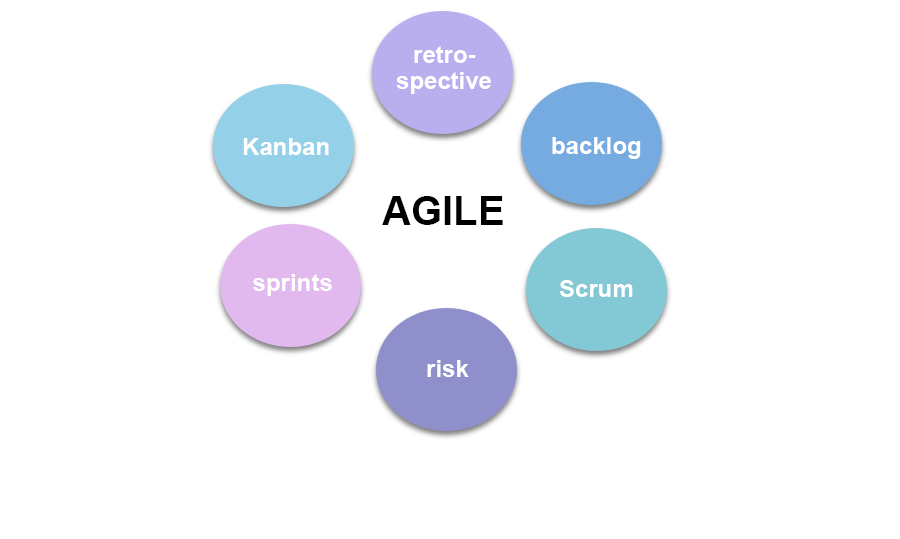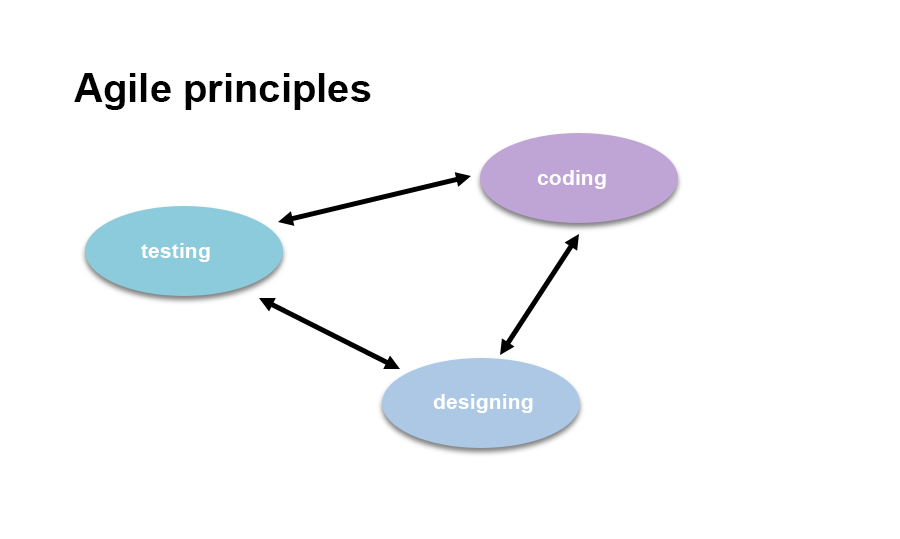Flexible development methodology (AGILE) – the methodology, based on the iterative method, whose conditions and solutions develop with the help of collaborative work of the self-organized and cross-functional teams.
Agile methods help to make the project management process more organized.Such projects require studying the adaptation processes, teamwork, self-organization, reports, and also testing.
Agile methods are considered the leading ones in projecting. Their aim is to rapidly deliver world-class software.
Also, this business approach connects the product’s development process with the user needs and the client’s expectations.
Flexible development can be compared to all existing development processes that are in accordance with the Agile Manifesto. This manifest has been developed by a group of 14 powerful IT experts. It reflects their personal experience regarding the approaches that contribute to delivering high-quality software.

Agile Methodology
The Agile methodology gives a team the possibility to not waste numerous months or even years with the process that will finally break due to a small defect, made at the primary stages. Instead, a team of developers collaborates directly with customers, in order to understand their needs and rapidly generate an optimized, qualitative solution.
Main principles of Agile Manifesto:
- People and their collaboration are more important than the processes and tools;
- The functioning product is more important than detailed documentation;
- Collaboration with a client is more important than specifying the details of a contract;
- It’s more important to be ready to implement new things than to follow a primary plan.
The advantages of Agile flexible development methodology
1. Better quality
By dividing a project into elements, a team gets the possibility to focus on the quality of development processes, testing, and collaborative work.
The software quality will be improved if you organize meetings and testing at every stage. Such tests will help to rapidly find and immediately fix the errors and inconveniencies at the primary stages.
2. Collaborative work with stakeholders
The flexible methodology offers numerous possibilities to work together with the stakeholders and a team before, during and after each sprint.
If a client personally goes through each stage of product development, he/she tends to collaborate with the development team; and this, in turn, will help a team to understand and see a final result.
When working software is delivered in time, the stakeholders express more trust to a team and remain really active in a project.
3. Customer orientation
To define the software features, Agile commonly utilizes user stories with the product’s acceptance criteria.
Customer orientation allows performing beta testing when each sprint has been ended, receiving important reviews when the project has been started and giving the possibility of editing if needed.
4. Transparency
According to the Agile method, clients can be involved in a project: prioritize, define a set of functions, make iteration plan and reviews, create software builds that comprise new functions.
But still, a client should understand that he/she looks at an unfinished project in exchange for the possibility to participate actively in its planning and development.
5. Orientation to the importance for business development
By giving a client the possibility to take part in defining the priorities, developers can understand that they are very important to a client since they can offer more useful functions.
6. Early release with a high level of predictability
Since a fixed sprint duration (1-4 weeks) is used, new functionality is delivered rapidly, frequently and predictably. This also helps to perform software beta testing earlier than planned if it’s important for a project.
7. The possibility of editing
When a team is completely focused on implementing the product’s functions that have been previously defined on all iterations, they have the possibility to constantly improve and distribute the product’s tasks.
New and edited elements of unfinished tasks can be moved to the next iteration and this will allow editing in the next few weeks.
8. Predictable expenses and delivery time
Since all sprints have fixed duration, costs are predictable and limited to a number of tasks, that can be performed by workers in a particular time range.
With the help of evaluation, given before each sprint, a client can evaluate average cost of every task. This helps to improve taking decisions on the importance of tasks and need in additional iterations.
Principles of flexible Agile development
- Working software is developed from 2 weeks to 2 months (short terms are preferred);
- The main priority is to satisfy a client by constantly delivering software in time;
- It’s necessary to continually analyze the work of a team, in order to improve its productivity;
- Simplicity is important, you shouldn’t do unnecessary work;
- Project development in a team of motivated workers. Supporting good relations and a positive environment in a team;
- Working software development is considered as progress for developers;
- Thanks to the flexibility of the processes, constant development can be possible. It’s really important since clients, developers and users should be able to maintain the pace on one level, without any time limits;
- The best way to transfer information among workers is to talk to each other.
- The speed of development is increased when a team pays enough attention to design and technical excellence.
- Only self-organized teams treat architecture and design in the most demanding way.
- Users and developers should work smoothly during the whole project;
- Requirements can be easily altered even at the final stages of development. This gives a client the possibility to be competitive on the market.

Agile Principles
Scrum and Kanban: flexible software development, the comparison
Scrum is a flexible methodology of project management, commonly used in software development projects.
Its main task is to increase the productivity of the teams and deliver new software once in 2-4 weeks.Scrum means creating highly sociable teams, with reviews from clients, having numerous customers that use the products, created for them, etc.
Kanban is considered one of the most popular methods of software development in the work of Agile teams.
Both Kanban and Scrum were created to improve the productivity of web testing companies.
Scrum vs Kanban
| Scrum | Kanban |
|---|---|
| A team takes part in a certain iteration | It’s not necessary to take part in it |
| Prior evaluation is mandatory | Evaluation is not mandatory |
| Speed is used to improve the process | Time limits are used to improve the process |
| Delay of a sprint of only one team | The board may be divided between several teams |
| At least 3 roles (owner, master, team) are used | There are no roles |
| Scrum board is changed between the sprints | Kanban board is never changed |
| Each sprint has its priority | Priorities are not mandatory |
Agile is a flexible software development methodology that offers numerous advantages not only for developers but for a client too.
Agile helps the developers to solve many issues that arise unexpectedly, is more efficient and faster.By reorganizing and rethinking the actions related to software development, Agile achieves the goals in a flexible and business-development way.










Leave A Comment